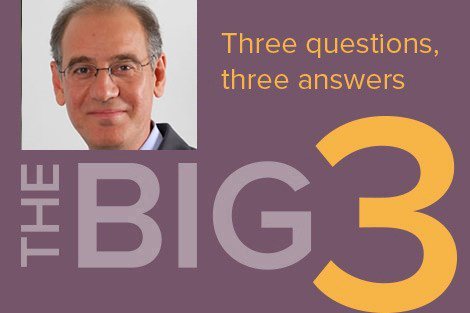November 13, 2018 – In an October 22, 2018 article in the Journal of Global Health, Rifat Atun, professor of global health systems at Harvard Chan School, and co-authors write that machine learning—a field of artificial intelligence in which computers are programmed to “learn” from large quantities of data and to progressively improve performance on certain tasks—has the potential to transform health systems.
Q: You put forth in your paper that artificial intelligence could help address some of the major challenges faced by health systems around the world. What are these challenges, and how could artificial intelligence help?
A: One major challenge facing health systems is the rising burden of illness and disability as the world population ages. The second is a shortage of resources—human, financial, and physical. And the third is productivity—health systems in most settings are highly inefficient.
My colleagues Trishan Panch, MPH ’10, of Wellframe, and Peter Szolovitz of MIT and I believe that machine learning could be harnessed to be the catalyst for such a transformation. It could help boost productivity, free up scarce human resources, and help improve health outcomes, all of which could help move the world toward one of the Sustainable Development Goals it has committed to: universal health coverage by 2030. For example, there’s a huge shortage of health professionals in many countries. Artificial intelligence and machine learning offer us the opportunity to take care of many tasks that humans currently perform, at lower cost. And if that helps nurses and other health workers free up more time, they could use that time for activities such as long-term care, which is critically important in all countries with aging populations, and which cannot be done by machines.
Q: What types of health care tasks could be given to computers that ‘learn’?
A: One example is the use of image recognition to read X-rays. Although X-rays are typically read by radiologists, much of this “reading” can be done using algorithms, which can be used to decide whether an image falls within the normal or abnormal range. This screening process can happen fairly quickly, with a high level of accuracy, and could release valuable time for radiologists to focus on other activities—for example, looking at more complex images or performing image-guided diagnosis and treatment of disease.
Machine learning could also help with screening and risk profiling. For example, with population-level data such as weight, blood pressure, and blood test results (to identify biomarkers of disease, one could very quickly identify which individuals might be at risk of a disease, or might actually have a condition such as diabetes or cardiovascular disease. Machine learning could use existing data on patients—their age, eating habits, smoking habits, exercise habits, alcohol use, family history—to produce a risk score. That information would then go to a health care worker, who can use it to inform decisions on advice or treatment. And the beauty of machine learning is that, over time, the algorithm can be refined to improve the sensitivity and the specificity of the diagnosis and the precision of a person’s risk score.
In addition, machine learning could be a game changer in improving the safety of interventions. For example, if one knows the characteristics of a patient or population, and if a medicine is given or an intervention is prescribed, machine learning can help identify whether there are interactions or potential interactions, then warn the prescriber of the risks. This could all be automated, instead of somebody going through pages and pages of information. It would identify where the risks are and minimize errors.
Once these algorithms are developed, the cost of running them is exceedingly low.
Q: Are there potential problems or challenges to using machine learning in health systems?
A: We need high quality data in order for machine learning to be widely beneficial. Currently, data collected in hospitals or other health institutions don’t “talk” to each other. It’s very difficult to merge these data sets into a large data pool to do the kind of analysis that would be useful for machine learning—although there are methods currently being developed for that.
We also need comprehensive data that doesn’t ignore marginalized or high-risk groups that may not be included in certain data sets. So we need to ensure that we have a diverse group of data scientists who understand population characteristics and take all of these characteristics into account when designing algorithms.
With incidences of data breaches often in the news, trust is also a big issue with artificial intelligence. It’s critical that adequate legal provisions be established so that people trust that their data will be properly managed and kept secure.
Another issue is that we may not understand well enough how the algorithms figure things out and come to certain decisions. For machine learning, we create algorithms, and the machine “learns” and creates new algorithms—so this means that there’s a risk of the algorithms themselves becoming “the decision-makers,” a potential scenario in which no one understands how the decisions are being made and on what basis.
Finally, we need good leadership, both to ensure that we have a regulatory environment that is effective enough to mitigate risk, but that enables us to harness the potential of machine learning. Right now there is a lot of jazz and razzmatazz, lots of meetings and conferences about the issue of machine learning, but when it comes to action and judicious regulation, it’s not happening. We need leadership at multiple levels—at the global level, at the country level, and at the institutional level to harness the benefits of artificial intelligence in order to realize the promise of universal health coverage in many countries.
